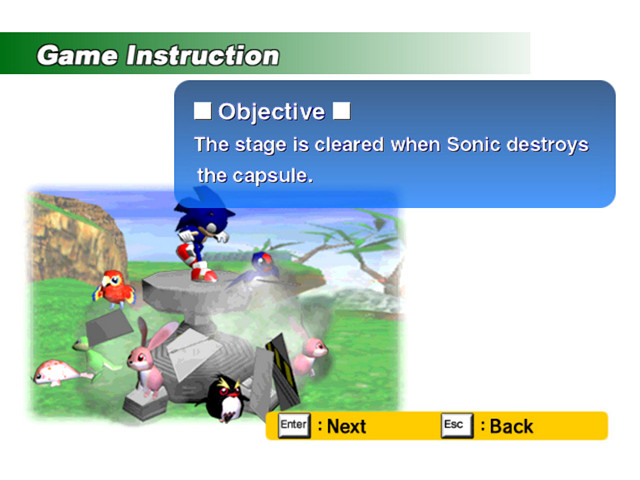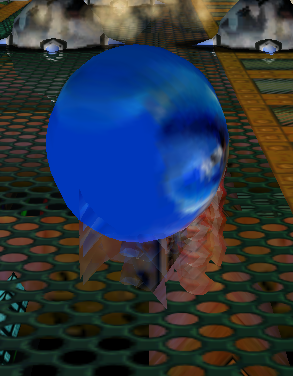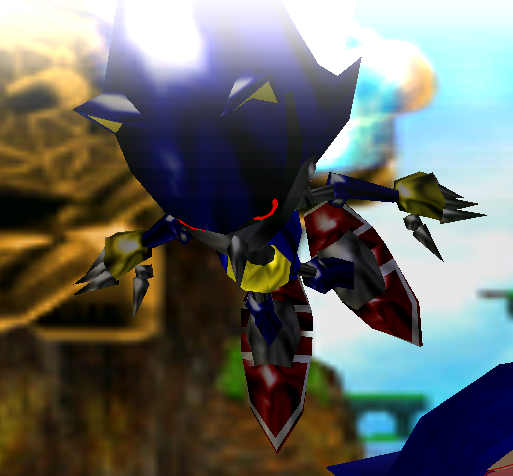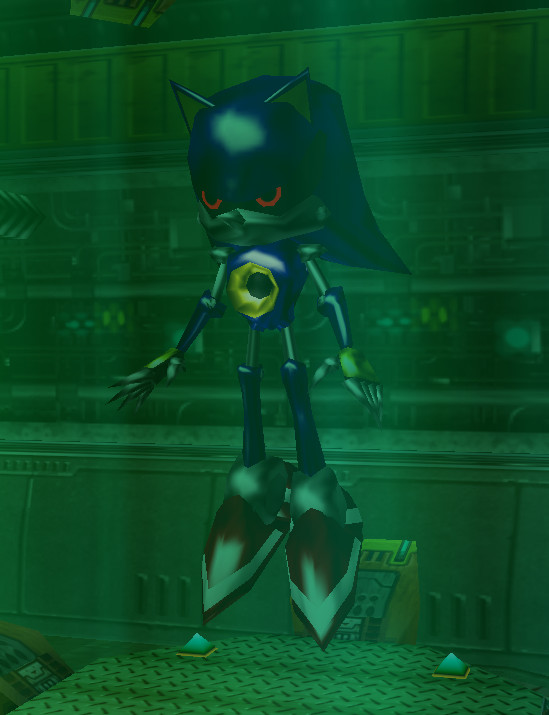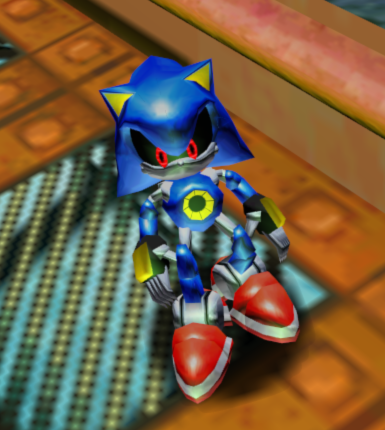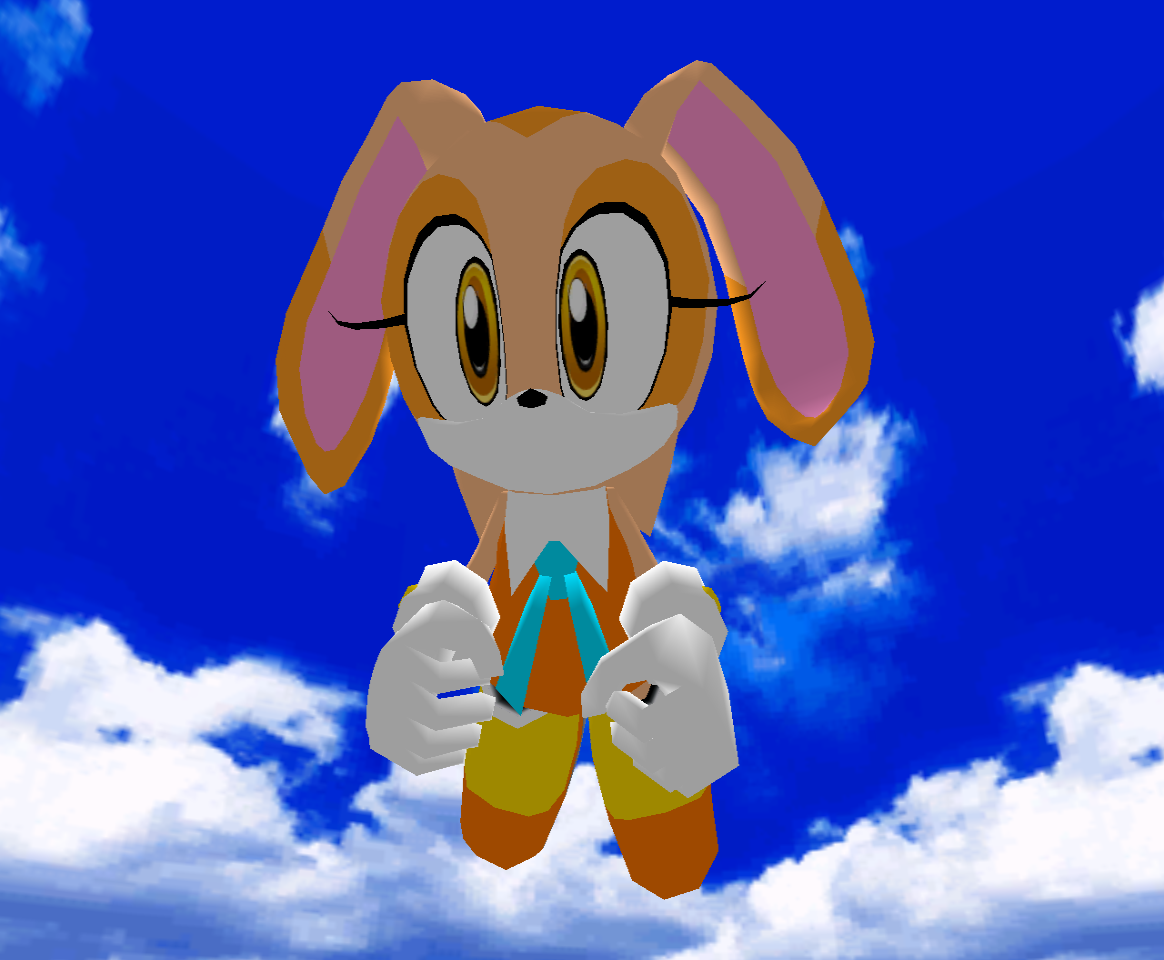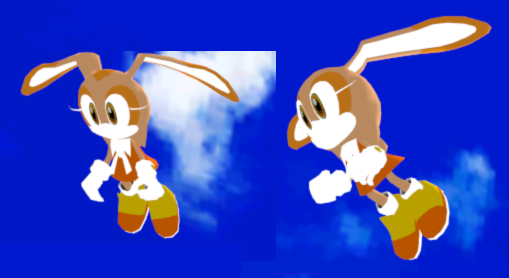Perhaps the biggest part that makes up the “Deluxe” or “Director’s Cut” branding of SADX is the new content that wasn’t available in the original Dreamcast version. Extra content adds to the game’s replay value and gives the player another chance to visit Action Stages and Adventure Fields with side quests that aren’t part of the main story. This concept works well in 3D adventure games, and it makes sense that it was attempted in SADX too. However, most of the new content in SADX is not exactly original, and often comes off as boring and uninspired. Before discussing it in detail, let’s summarize what the “DX” content offers in the following list:
- Mission Mode: 60 mini-quests are available by starting the game in Mission Mode and picking up Mission Cards
- Mini Game Collection (Gamecube/PC 2004 only): getting emblems and completing missions unlocks several 8-bit Sonic games that are playable via a built-in SEGA Game Gear emulator
- Achievements and online leaderboards (Steam/nextgen consoles only)
- Collecting all emblems unlocks Metal Sonic as a playable Trial Mode character, whereas in the original game emblems didn’t unlock anything
- Adventure Fields have maps, which can be accessed from the Pause menu
- There’s a Manual Camera mode that you can select in the Pause menu
- Several times during the story you can see Cream flying around
To be fair, that’s quite a lot of extra content for just a port of an older game. It wouldn’t be a problem if it was well implemented; however, SADX seriously lacks in execution. Let’s start with the least problematic aspects of the new content and discuss some of its relatively minor design flaws:
- The honeycomb transition used in the Mini Game Collection menus is never used elsewhere in the game, which looks jarring. The only other time the honeycomb pattern can be seen in a menu is some Adventure Field maps, but those are not animated and use a different background, and not even all maps have it. It is quite obvious that the menu was added without much care for the style of the original menus. One could argue that the original menus were badly designed anyway, which is perhaps true, but this inconsistent attempt to add a new menu doesn’t improve the overall picture.
- The rest of the menus for extra content don’t have any transitions at all, which makes it even more jarring. For example, the tutorial for Mission Mode doesn’t have background fade animations unlike its Adventure Mode counterpart. It also clashes in style with Adventure Mode tutorials because it uses a different font and has screenshots featuring SADX Sonic and environments, whereas the tutorials weren’t updated in the port and are still featuring SA1 characters and environments. Adventure Field maps and Mission Mode stats also just pop up without any fade or zoom animation, which makes them look rough and unfinished. In the original game all menus except the pause box have animations, so it is quite easy to tell what was in the game originally and what was slapped on later.
- The pause menu in the Game Gear emulator is inconsistent with the rest of the game. Instead of a violet rectangle it uses a rounded rectangle like the pause menu in the Dreamcast version, but its background color doesn’t match either version of the game. The buttons are also inconsistent with other menus in either game.
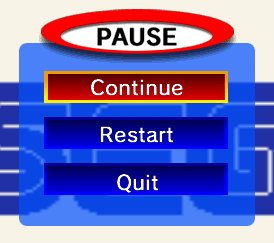
- The Game Gear emulator doesn’t scale with the resolution in the PC version, which means the game will be in a small window in the center of the screen at any resolution higher than 640×480. This makes the Game Gear games nearly unplayable at higher resolutions such as 1080p or 4K. To be fair this was less of an issue back when the 2004 PC port came out, but even at resolutions like 1024×768, which were common at the time, the problem is visible. It would have been nice to have it scaled properly.
- The Mission Mode stat screen tries to imitate the style of the Character Select screen, but fails because its fonts are visibly different and because it’s missing a fade transition.

The issues described above can be annoying to some people, but they aren’t dealbreakers and can be considered nitpicking for the most part. However, these are also indicators of the lack of effort put into the ports, including the extra content. Let’s move on to something more substantial to see how it manifests in the extra content’s quality.
The Mission system is the largest scale addition to SADX, and probably the most valuable too because it gives you a reason to revisit the stages and fields. However, the problem with SADX missions is that they are uninspired at best, and plain nonsensical at worst. This Sonic Wikia page lists all 60 SADX missions and what you need to do to complete them. There’s also a video walkthrough of all missions. Here are some examples:
Bring the man who is standing in front of the burger shop!
He is going to drown! Help the man in the water!
Lonely Metal Sonic needs a friend. Look carefully.
The burger shop statue was a funny easter egg in the original game, but the missions go way overboard in using it. While the first mission might pass as a tutorial to get the player used to the Mission Mode mechanics, the other two are simply variations of the first one: carry the burger shop statue from A to B. It is also strange how all of these missions refer to the burger shop statue as if it was a person, even though it has no animation. This would have been a nice opportunity to expand on the original easter egg, but it was wasted with poor execution.
Who is Chao a good friend with? And what is hidden underneath it? – Apart from sounding like an awkward translation from Japanese, this mission doesn’t make much sense. What’s hidden underneath what? Before you adjust to the game’s logic it may take you a while to figure out it wants you to dig next to the billboard with a picture of Cream.
I hate this dark and filthy pace!’ Can you find it? – Again, bad translation/spelling and treating Cream’s billboard as Cream herself. If it’s Cream saying that, why not have her standing there instead of the billboard? That makes more sense than her cameos in Station Square that force rotate the camera against your will so that you could see her at all, but we’ll get to those later.
Perhaps the intention was to make these missions sound ironic or humorous. There’s an opinion that part of the fun is figuring out what you have to do from vague mission instructions. On the other hand, one could also argue that mission objectives are simplistic on purpose, to appeal to younger audiences. However, compared to the game’s main quest the missions are low quality, both in terms of poor wording and variety of objectives. This is the cheapest kind of “fun” to introduce as extra content besides replaying the stages with mini-objectives, like the A/B rank missions in the original game.
There are many more examples of nonsensical SADX missions, but even with the above it is possible to notice some patterns. In general, all SADX missions fall into one of the following categories:
1. Take the burger shop statue (or a reskin of it) and carry it from one place to another.
2. Find a preset object (billboard, flag, balloon, Sonic token) and touch it.
3. Destroy X badniks and optionally go somewhere.
4. A variation of 2/3: press a button to activate a timer and destroy or collect X objects before the time runs out.
5. Collect X rings and optionally go somewhere or touch an object from 2.
6. (Big’s missions) Catch a pre-determined fish in a specific place.
On the surface these don’t sound too bad, and it was entirely possible to create, say, 20 fun and unique missions, but SADX definitely went for quantity over quality.
One problem with SADX missions is that the challenge comes not from the actual task, but from fighting the game’s buggy physics system. Many missions are made almost impossible to complete on purpose, and are incredibly frustrating as a result. For example, in Mission 53 you have to perform a series of very specific jumps, which is quite difficult – not because it is challenging, but because the physics are kind of broken. Mission 54 is only slightly less frustrating.
Some missions are frustrating because they make you fight both the physics and the camera. In Mission 58 you have to collect all flags in Lost World Act 2 while the falling rock chases after you. It is impossible to complete on the first try because you can’t even see the flags from that camera angle, so the entire mission is about trial and error. The best way to beat it is to let the rock roll down all the way and then climb back up the path you came from, fighting the camera at the same time.
We have already established that mission descriptions suffer from poor translation. In addition, they break the game’s general rule of using only two lines of text at a time. Mission Mode is the only area in the game where this rule gets broken:
The objects used in Mission Mode aren’t particularly unique: only the billboards and flags are new objects that aren’t found elsewhere in the game. SADX recycles models from the main game for mission objects: the Spinner enemy appears in a many missions, the balloon is Amy’s escape balloon, Sonic tokens use the same model as the spinning Sonic coins in Casino, and the Mission Card is the employee ID card used in the original game for getting passage to Speed Highway.
SADX missions are uninspired, frustrating, samey and unoriginal, but perhaps they’re better than nothing? Maybe, but the Dreamcast version also had extra content, and in some ways it was quite a bit richer than the lackluster Mission Mode. So let’s talk about Sonic Adventure DLCs and compare them against SADX missions.
Before discussing the DLCs, let me just get one thing out of the way. Some people claim that Sonic Adventure’s extra content requires the Dreamcast to be connected to the Internet and, because the official SA1 website went down, this content is no longer accessible. This is actually not the case. The SA1 website has been brought back online by dedicated fans, and you can access it the same way you could in 1999 – complete with monthly events you can participate in! Secondly, you can get the DLCs without connecting the Dreamcast to the Internet – by using one of the VMU backup CDs. SADX still has the advantage of having all the extra content bundled directly with the game, of course.
If you do access the SA1 website, however, it gets quite close to SADX in terms of features. There are maps for Adventure Fields, gameplay tips for each character, and the Chao Daycare system where you can upload your Chao. The site also has the Chao Black Market where you can buy rare Chao for emblems (this was the purpose of SA1 emblems all along, but the feature never worked in the US when the Dreamcast was still officially supported). But most importantly, you can get various event DLCs.
Sonic Adventure was one of the first console games to have DLCs, which were all free. After downloading a small file onto the VMU, new content was added to (or unlocked in) the game. Even though the DLCs were simple in nature, it was pretty fascinating for a 1998 game. I’ve recreated Dreamcast DLCs as a mod for SADX, so you can experience them in the PC version. In this post we aren’t going to talk about every DLC, but here’s a post that describes all of them.
SA1 had only a few DLCs, and many of them were simple decorations rather than new challenges. However, in some ways the DLCs were more unique than SADX missions. Every DLC added some unique objects, be it Reebok shoes, Christmas trees or gold rings to celebrate the year 2000. The DLCs also have some advantages to SADX missions:
1) The DLC system allows to add new assets without touching the base game. Even today it’s still possible to create custom SA1 decorations and challenges that add completely new models, textures, sounds and music without hacking the main game. A custom challenge has already been made for the original game. By contrast, SADX uses a set of hardcoded “mission objects” discussed earlier, though it can also load any object from a specific level’s object list (such as the “fugitive” in Red Mountain)*. That apart, the SA1 system is more versatile and “futureproof” than the hardcoded SADX system. While this barely matters to the player, isn’t it quite revealing that a DLC system designed for downloadable content in a 1998 Dreamcast game is technically superior to the one used in the supposedly “enhanced” port that came out on more powerful hardware 5 years later?
*Speaking of that particular mission, the “fugitive” has no animation (unlike the regular Red Mountain prisoners that are animated), and when you find him the platforms under Sonic disappear and he falls straight into the lava.
2) The timers and counters used in SA1 DLCs can work across different stages, which makes it possible to create challenges spanning across several locations (for example, the QUO DLC takes place in both Station Square and the Mystic Ruins). SADX counters and timers reset as soon as you leave the area, so all SADX missions are restricted to one act in one level.
3) Despite being simplistic overall, SA1 DLCs provide more content than SADX missions. For example, there are no SADX missions that change music (Christmas 98 and 99, Y2K, Samba GP) or unlock new Twinkle Circuit courses (Samba GP). SADX could have used that because there are five unused Twinkle Circuit courses still in the game. SA1 DLCs also change the stages a lot more – apart from decorations (that are also not found in SADX missions), SA1 DLCs sometimes add new platforms or obstacles (AT&T challenges). As basic as the DLCs are, they still seem more creative than SADX missions.
4) Even though the Steam and nextgen console versions of SADX have online leaderboards (which SA1 also had), there’s no competitive element to the missions. By contrast, SA1 events offer time challenges where you can compete with other players. At some point there were even real life prizes! Even today you can still compete against other players in those challenges if you connect your Dreamcast to the Internet (AT&T, Reebok, Samba GP etc.).
With all of the above taken into consideration, it is safe to say that SADX Mission Mode wins quantity and challenge wise, while SA1 DLCs win quality, variety and creativity wise. So in some ways, downloadable events in a 1998 game (the biggest being <50KB in size) are more varied and creative than missions in a 2003 game that had the advantage of using more powerful hardware and being able to store more extra content on the disc.
Now let’s talk about Metal Sonic. Metal Sonic is simply a Sonic model swap with one extra running animation, and it’s also broken in multiple ways:
1) In all versions of SADX except the Gamecube version his voice clips are missing. Even in the Steam/nextgen console ports, which switched back to ADX audio for voices and music.
2) When Metal Sonic is not moving, he is always leaning on a side, even when he is standing on a flat surface. It almost looks like a bug, but judging by the game’s disassembled code it is intentional. One possible reason is that the standing animation was changed to prevent Metal Sonic from saying Sonic’s idle lines after staying still for too long.
3) Metal Sonic’s afterimage effect has transparency problems with almost everything. It was supposed to look similar to Sonic’s fake “motion blur” in SA1, but it renders behind everything and ends up looking strange half the time. Here is a typical example seen when Metal Sonic is jumping on a background that has any sort of transparency:
4) Similar to the updated Sonic model, Metal Sonic has strange looking eyes in his “climbing” animation, though at least the pupils are visible:
5) Minor point, but since Metal Sonic is a robot, why doesn’t water damage him, and why can he drown? It’s just a reskin of Sonic that plays exactly the same. Instead of this addition, they could’ve implemented Super Sonic in Action Stages in SADX, especially since leftover data in SA1 indicates that Super Sonic was meant to be playable in Action Stages at some point. Thankfully there are fan-made Super Sonic mods for the PC version.
6) The Metal Sonic model is inconsistent with his other appearances in the game. SADX Metal Sonic looks nothing like the one seen in the tube at the Mystic Ruins base, or the one from Amy’s flashback. This is what Metal Sonic is supposed to look like (alternative screens from vanilla SADX PC: 1 and 2):
Instead, this is what he looks like in SADX:
The playable Metal Sonic uses the model from SA2B without accounting for the original game’s assets and design. Thankfully the Dreamcast Characters mod has an option to use the correct Metal Sonic model.
7) When you go to the character select screen after beating a level in Trial Mode as Metal Sonic, vertex welding on all other characters breaks, and you can see the seams between characters’ joints. This is quite a sad oversight because Metal Sonic doesn’t even use vertex welding. Fixing it was simply a matter of resetting the Metal Sonic flag when loading the character select screen.
To unlock Metal Sonic in SADX, you need to collect all emblems. In the original game the emblems didn’t serve much purpose (other than buying rare Chao via the Black Market website in Japan), so you didn’t have to beat all Chao races or clear all Trial missions as Big, which are commonly known as frustrating. In SADX, however, you have to beat all Big missions and Chao Races to unlock Metal Sonic and get the achievements. While this does make emblem collection more rewarding for some, it makes the game more frustrating to complete for others. But the most frustrating part is that Mission Mode and Metal Sonic are locked behind a paid DLC in the nextgen console ports. So essentially you cannot even complete the game 100% on the PS3 and Xbox 360 if you don’t buy the “DX” DLC. You also have achievements in the base game that you can’t unlock without buying the DLC.
Finally, let’s talk about Cream. We’ve already discussed strange missions featuring her billboards, but Cream herself does show up ingame. You can see her flying around Station Square after a cutscene in each character’s story:
From the above video you may have noticed that something’s off about Cream’s overall appearance. This is what she is supposed to look like:
Cream is broken in all versions of the game except the Gamecube. Her model is missing several textures and looks strangely lit up on PC and in the nextgen console ports. The function to draw Cream’s model has some buggy code, and the technical execution of the cameo is also quite strange. Instead of the traditional Dreamcast animation format used elsewhere in SADX, Cream has a separate model for each frame of her animation. Perhaps that was the quickest way to get a Sonic Heroes model to work in SADX.
To conclude, a lot of extra content in SADX appears to be poorly thought out, with questionable, sometimes outright broken implementation. Instead of extending the main game with extra content, SADX introduces new content that clashes with original designs and is overall inconsistent with the rest of the game. In several cases a Dreamcast game that came out in 1998 can pull off more impressive tricks than a supposedly “enhanced” port that came out on a more powerful system 5 years later.
